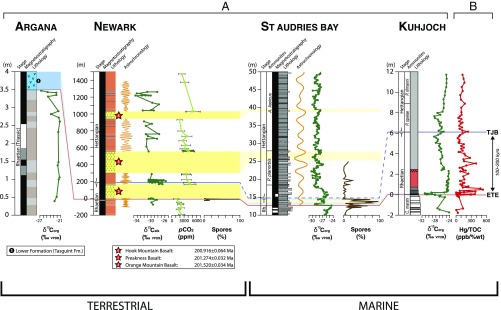Fig. 1.
(A) Stratigraphic correlation of the end-Triassic extinction with the Moroccan Lower Formation CAMP basalt. Argana lithology, carbon isotope, and paleomagnetic data are from ref. 14. Newark lithology and pCO2 data are from ref. 22; paleomagnetic and astrochronological data are from ref. 48; carbon isotope data are from ref. 12; and trilete spore data are from ref. 49. St Audries Bay lithology and astrochronology are from refs. 42 and 50; biostratigraphy and carbon isotope data are from refs. 10 and 50; trilete spore data are from ref. 51; and paleomagnetic data are from refs. 52 and 53. Stratigraphic correlation of CAMP units between Argana, Newark, and St Audries Bay is based on refs. 12 and 42. Kuhjoch biostratigraphy, lithology, and carbon isotope data are from ref. 11. The end-Triassic extinction horizon (marked as ETE) and Triassic–Jurassic boundary (marked as TJB) are also shown. (B) Example of Hg/TOC dataset from this study (Kuhjoch, Fig. 3) is shown to stratigraphically correlate with the lowest CAMP basalt unit that intersects the end-Triassic extinction horizon at Argana. See SI Appendix, Fig. S2 for a full stratigraphic correlation of end-Triassic records.

